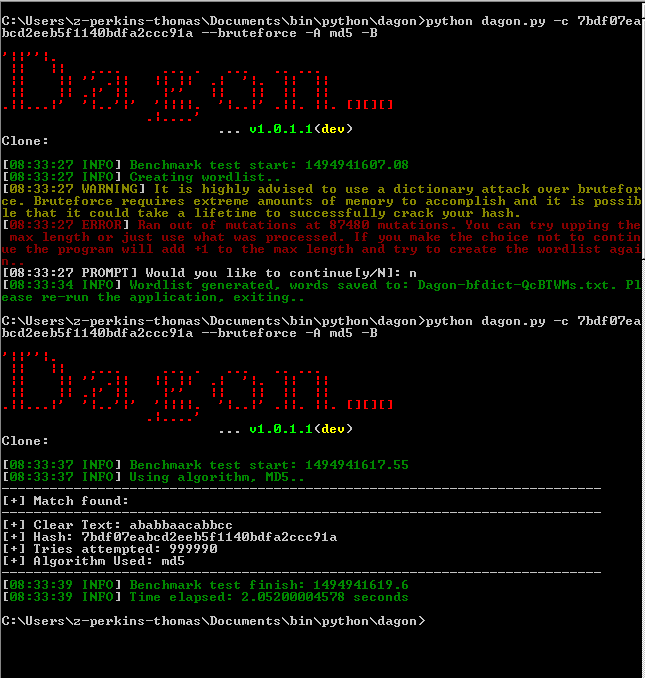Python Md5 Brute Force
- Python Md5 Brute Force Tutorial
- Python Md5 Brute Force Programming
- Brute Force Attack
- Brute Force Sandbags
I use python 2.7, and I have a simple multitheaded md5 dict brute: # -*- coding: utf-8 -*- import md5 import Queue import threading import traceback md5_queue = Queue. Python Parallel hash bruteforce. @Blender This is just a learning exercise and python is the language I understand the. Parallelize brute force generation. How to write a brute-force password cracker. The algorithm is md5(concat(md5(password), salt)). Here is my code written in python. This module implements a common interface to many different secure hash and message digest algorithms. Included are the FIPS secure hash algorithms SHA1, SHA224.
Improved brute force hash cracker supports md5, sha1, sha224, sha256, sha384 and sha512 in Python. Try this script. I estimate it would take half of a second to run. all = ('bruteforce', 'crack', 'makelibrary') encryptions = 'md5', 'sha1', 'sha224', 'sha256', 'sha384', 'sha512' import hashlib from random import randint from os import exit, mkdir from sys import stdout, argv from atexit import register from time import sleep from os import fsync, rename class bruteforce: def. There is a bash script written by Salim Haddou of F5 Networks called snmp0wn-md5 which performs this brute force process to find MD5-based auth passwords. However, this tool took 24 minutes to process a sample set of 20000 words, which is a hash rate of 13.8h/s.
Note Feeding string objects into update() is not supported, as hashes work on bytes, not on characters. Constructors for hash algorithms that are always present in this module are sha1(), sha224(), sha256(), sha384(), sha512(), and. Md5() is normally available as well, though it may be missing if you are using a rare “FIPS compliant” build of Python.
Additional algorithms may also be available depending upon the OpenSSL library that Python uses on your platform. Program De Verificare Plagiat Gratuit. On most platforms the sha3_224(), sha3_256(), sha3_384(), sha3_512(), shake_128(), shake_256() are also available.
Sha224 ( b 'Nobody inspects the spammish repetition' ). Hexdigest () 'a4337bc45a8fc544c03f52dc550cd6e1e87021bc896588bd79e901e2' hashlib. New ( name [, data ] ) Is a generic constructor that takes the string name of the desired algorithm as its first parameter. It also exists to allow access to the above listed hashes as well as any other algorithms that your OpenSSL library may offer. Fast And Furious 5 Rio Game here. The named constructors are much faster than and should be preferred. Using with an algorithm provided by OpenSSL. Changed in version 3.1: The Python GIL is released to allow other threads to run while hash updates on data larger than 2047 bytes is taking place when using hash algorithms supplied by OpenSSL.

Digest ( ) Return the digest of the data passed to the method so far. This is a bytes object of size which may contain bytes in the whole range from 0 to 255. Securecrt 7.0.3 Portable Win X86 more. Hexdigest ( ) Like except the digest is returned as a string object of double length, containing only hexadecimal digits. This may be used to exchange the value safely in email or other non-binary environments.
Copy ( ) Return a copy (“clone”) of the hash object. This can be used to efficiently compute the digests of data sharing a common initial substring. SHAKE variable length digests The shake_128() and shake_256() algorithms provide variable length digests with length_in_bits//2 up to 128 or 256 bits of security. As such, their digest methods require a length. Maximum length is not limited by the SHAKE algorithm.
Digest ( length ) Return the digest of the data passed to the update() method so far. This is a bytes object of size length which may contain bytes in the whole range from 0 to 255. Hexdigest ( length ) Like except the digest is returned as a string object of double length, containing only hexadecimal digits. This may be used to exchange the value safely in email or other non-binary environments.
ok so I'm very new to python and I know java pretty well...
Here is the source code I have come up with for the beginnings of a md5 brute forcing program:
So when I try and run this code I get a syntax error on line 1... which seems weird to me because I think I am importing os right. I really have no clue what is wrong with this code. Even though it looks as if the tuple is over multiple lines it really is only a single line on my .py file. Can anyone help me?
By the way, I am going to embed a fork bomb in this program (so that my friend will get owned when he runs it) :D so I suggest you keep os.fork() as a comment, if you run this.
Thanks
- 4 Contributors
- forum9 Replies
- 763 Views
- 1 Year Discussion Span
- commentLatest PostLatest Postby musturd
Python Md5 Brute Force Tutorial
Recommended Answers
Try running it using 'python program_name'. You don't have anything in the file to tell the OS that it should use the python interpreter when running it. 'import os' is not a valid bash statement (or a MS Windows statement).
Jump to Posthey, didn't we just have this conversation over in C, like, a day ago?
basically it's three simple things:
Python Md5 Brute Force Programming

-- post your code when you want specific help.
-- use [code] tags so we can read your code.
-- don't hijack other people's threads.
bumping a 2 year old thread …
Jump to PostBrute Force Attack
All 9 Replies
Brute Force Sandbags
Try running it using 'python program_name'. You don't have anything in the file to tell the OS that it should use the python interpreter when running it. 'import os' is not a valid bash statement (or a MS Windows statement).